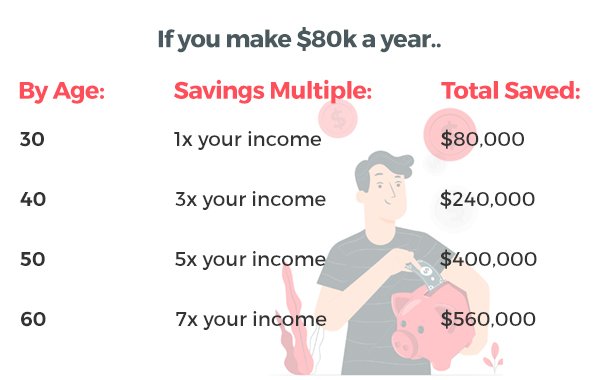A fundamental question to ask when you’re starting off your personal finance journey and/or reviewing your goals.
The rule of thumb is to save 10% of your monthly income, the more you save the faster you can stockpile retirement or savings goals money.
I remember my start in really looking at my finances. After graduating college, I still didn’t focus on it much. The goal was just to “make” money and somehow things will all fall into place.
3-4 years passed and I wasn’t getting anywhere. I just worked and lived month-to-month, figuring out what I could keep after my monthly expenses and not having any plans for savings.
I wasn’t married yet and didn’t have any kids, why did I have to bother right?
If only I had a mentor or friend discipline me a bit better. I got started really working on my personal finances around 2014, and I was so grateful that I did.
It all just started with me asking questions to myself, Googling what I didn’t know, and building off that.
Before 2014, if I could, I would save $25 here $50 there, and put it in an envelope as extra money.
I’d also go back and take money out of that small fund if I needed it for anything, no structure.
Now, I have a very specific way of directing any money that is made on a monthly basis, whether thats $1,000 or $10,000.
I’ve made it all a system. let’s dig deeper into it now.
Level 1 – Save at least 10% to start

Forget everything else, if you haven’t started saving before, than just start by looking at your monthly income, and planning to save 10% for it at the minimum.
If you’re working for a company and are on the payroll, that means you get to see consistent income and can predict potential savings funds for months out.
If you’re making $2,000 a month, start saving $200 per month for your emergency fund. This is the first of many funds you will want to save for.
A quick note on emergency funds: This fund is what will help you get out of sticky situations. No stressing over getting 2 new tires for your car, or paying for some $400 home AC repair. The goal here is to figure out your monthly expenses and save up to a year for it, start small and work your way up to it. I wrote an in-depth article on starting and growing an emergency fund.
Also, if you’re around 20, I made a specific post on how to invest like a pro at 20. Combine this post and that one to create a successful plan for solid future growth.
Get to retirement quicker by saving more than 10%
The 10% rule that is popularly known is just the start. It’s your 5 lb weights that you’re using to start your workout journey. Once you can lift that much with ease, you need to lift heavier.
I’ve spoken to mentors and friends who have shared their savings strategies, and they’ve been an eye opener.
Some saved as much as 60% of their monthly income towards various savings goals (emergency fund, new house, investing).
Does that sound too crazy for you? It might.
My takeaway here was that they were lifting 60 lb weights, and I couldn’t do that just yet. But I had to definitely step up my game and save money next month to see if I could pass the “stress test”.
So over the months, I started saving 10%, then 20%, some months back to 10%, and some months as much as 40%.
It didn’t have to be a fixed rule.
If I could save way more one month, awesome! But if I had to buy plane tickets and also pay the car insurance, then funds were tight, and I had to at least meet my minimum 10% savings goal.
The takeaway here is to start at 10% but quickly try to go higher after 4-5 months of saving.
Remember to also always make it a habit to save every month, the more you make this a habit, the easier you can meet the savings goal.
Level 2 – Write down what you’re saving for, and how much should go in each pot monthly

We’re gonna keep the workout analogies going here.
If you’ve been saving 10% consistently for your emergency fund, you can try to workout other areas to get to those goals too.
Remember that your emergency fund, your first savings goal, should be ideally 1 year of your monthly expenses.
If you are married with no kids and have a combined income of $5,000 and monthly expenses of $3,500 then your total emergency fund goal should be $42,000.
This is a long term goal, so don’t freak out. You work your way towards that goal, and when you get there, life will be great. You won’t have to stress about bills that are a few hundred or thousand dollars. You have the money now.
Let’s say you’ve been saving for your emergency fund now for some time, and you’ve saved 4 month’s worth in the emergency fund.
You can now choose to add other fund goals to save towards, alongside the emergency fund goal.
Once I had 3 months of expenses saved in my emergency fund, I started building out savings towards..
- Downpayment for a new house
- Downpayment for a future car
- Future vacation
I was able to save 20% of the household income most months after 1-2 years of getting in this habit. I would now take that 20% and spread that money 4-way for all 4 of my savings goals.
It was exciting to see the money grow, especially over the months.
Around 2017, we had already paid off one of the family cars, yet I kept the “downpayment for a future car” fund going and adding to it monthly.
I did this so that any future car purchase down the road was easily funded. I wouldn’t use this fund money for any other purpose than that.
Level 3 – Make your savings money grow faster

I already talked about how you could make your savings money grow faster by simply saving a higher percentage of your monthly income.
The next thing you could do to get smarter is to get the highest interest rate possible for your savings account.
Most banks these days give some terrible interest rate in the ballpark of 0.20%.
It’s ridiculous to me, because the bank I use gives me a 1.75% interest rate, that’s a hugeeeee difference.
Let’s look at an example, say I have $12,000 saved in my emergency fund.
- At 0.20% interest, you’d get a $24 return.
- At 1.75% interest, you’d get a $210 return.
See how that worked?
My tip is, once you get above about $5,000 saved, start looking for a place to house all your future monthly savings, so that you get the best interest rate possible and make your money earn more money (a secret of the wealthy).
Go check out my post on the top 5 savings account with the highest interest rates. I use Capital One 360, btw.
How much should I save each month for retirement?
This is a bit heavy of a question to add here, i’ll dedicate a whole new post to it.
In short, you want to save for about 15-20 years of your planned yearly expenses during your retired years.
Let’s say you plan on spending an average of $50,000 per year while you’re retired.
This means you’d want to save around $750k to $1m.
Depending on your current age, and factors like if you’re going to invest it all to help it grow to that retirement number, you’ll then be able to figure out how much you should be saving each month towards retirement.
Another way to do this is to multiply your income to get your goal
This is sometimes easier to understand, take your current yearly income and multiply it by your age below to see how much you should have saved towards retirement.
Follow this chart I made:

Note that this could be your own yearly income for now, and then change to household income after you get married.
The formula could stay the same, but your yearly income will definitely increase over time, so make sure to revisit this process at least once a year, and update it to see your new numbers.
You could consider incorporating it into your personal savings spreadsheet to make it easier to access/edit and remember to review.
These 2 methods I shared, among many others you might find online, are helpful but need to be personalized to your own needs.
You might have a frugal lifestyle, or live in an area where expense for housing and food are much lower than other parts of the country.
Have a vision of what your lifestyle will be like after retirement. Will you downsize or stay in the same larger house? Do you want to vacation more or spend time with family? Consider your expenses and plan your retirement needs accordingly, don’t let large numbers stress you out.
If you don’t know what retirement might be like (most of us don’t), make up a scenario. Over time, as you review it, you’ll want to change parts of it, and get more clarity of how you and your spouse would like to retire.
Saving is easy, don’t let it overwhelm you

I shared the different levels that you’ll experience as you grow in saving and get better at it.
But saving itself is easy, I really think that most of us can look at our monthly income and try to save 10% for an emergency fund and future goals.
If you find this hard to do, then it’s the perfect time to look at your monthly expenses to see what you could change or remove.
Just get started, don’t wait for any perfect plan.
Learn as you go, and read some of my other articles to get even more insights into growing your personal finance muscles. Let’s do this! 💪

